Lecture 2
5.0(1)
5.0(1)
Card Sorting
1/58
Earn XP
Description and Tags
Clinical Aspects of Dental Anatomy, Histology and Physiology in Operative Dentistry
Study Analytics
Name | Mastery | Learn | Test | Matching | Spaced | Call with Kai |
|---|
No study sessions yet.
59 Terms
1
New cards
Teeth & Investing Tissues:
Dentition
Classes if Human Teeth
Physiology of Tooth Forms
Structures of the Teeth
Classes if Human Teeth
Physiology of Tooth Forms
Structures of the Teeth
2
New cards
Dentition
Term that describes all of the upper and lower teeth collectively.
3
New cards
Arches
The teeth are normally arranged in the maxillary and mandibular arches
4
New cards
Quadrants
Each half of the arch
Each arch can be divided in half by an imaginary vertical line (Midline)
Each arch can be divided in half by an imaginary vertical line (Midline)
5
New cards
Primary Dentition
Also called baby, milk, lacteal teeth
Consist of 20 teeth in all; (10 upper & 10 lower teeth)
Begin to merge about 6 months of age and is completed around 2 – 3years old.
Consist of 20 teeth in all; (10 upper & 10 lower teeth)
Begin to merge about 6 months of age and is completed around 2 – 3years old.
6
New cards
Permanent Dentition
Composed of 32 teeth in all (16 upper & 16 lower teeth)
Emerged at 6 years of age and gradually replace the smaller primary/deciduous teeth
Eruption process is completed by 12-13 years EXCEPT the four 3rd molars which erupt around 18-25 years of age.
Emerged at 6 years of age and gradually replace the smaller primary/deciduous teeth
Eruption process is completed by 12-13 years EXCEPT the four 3rd molars which erupt around 18-25 years of age.
7
New cards
Classes of Teeth
Incisors
Canines
Premolars
Molars
Canines
Premolars
Molars
8
New cards
Incisors
Cutting or shearing instrument
9
New cards
Canines
Seizing, piercing, & tearing of food as well as in cutting.
10
New cards
Premolars
Dual role: like Canines in tearing of food; like Molars in the grinding of food
11
New cards
Molars
Crushing, grinding & chewing of food to the smallest dimensions suitable for deglutition
12
New cards
Dental Notation
PALMER’s Notation System
UNIVERSAL Numbering System (adopt by ADA)
FDI System / ISO – Two digit system
UNIVERSAL Numbering System (adopt by ADA)
FDI System / ISO – Two digit system
13
New cards
Palmer’s Notation System
Permanent - Quadrant Sign and Number 1-8
Deciduous - Quadrant Sign and Letters A-E
Deciduous - Quadrant Sign and Letters A-E
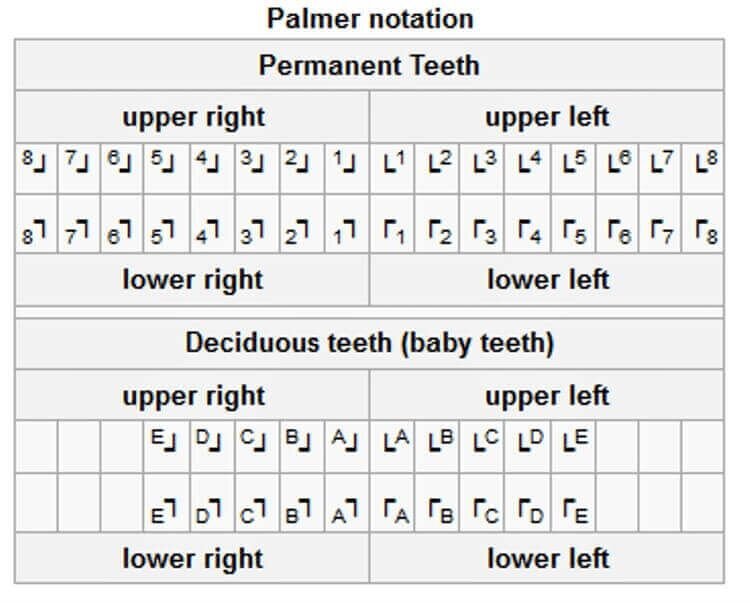
14
New cards
Universal Numbering System
Permanent Teeth - Denoted by numbers 1 through 32
Deciduous - Denoted by A to T
Deciduous - Denoted by A to T
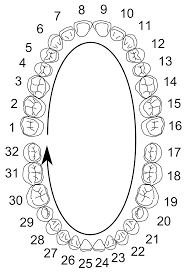
15
New cards
Two Digit System/Federation Dentaire Internationale (FDI)/International Organization for Standardization (ISO)
Each tooth (permanent/deciduous) is given a two-digit number
The first digit indicates the quadrant and whether the tooth is permanent or deciduous.
PERMANENT DENTITION
\#1 – maxillary right quadrant
\#2 – maxillary left quadrant
\#3 – mandibular left quadrant
\#4 – mandibular right quadrant
The second digit identifies the particular tooth in the quadrant (1-8)
\
DECIDUOUS DENTITION
The first digit indicates the quadrant
\#5 – maxillary right quadrant
\#6 – maxillary left quadrant
\#7 – mandibular left quadrant
\#8 – mandibular right quadrant
The second digit identifies the particular toot in the quadrant (1-5)
The first digit indicates the quadrant and whether the tooth is permanent or deciduous.
PERMANENT DENTITION
\#1 – maxillary right quadrant
\#2 – maxillary left quadrant
\#3 – mandibular left quadrant
\#4 – mandibular right quadrant
The second digit identifies the particular tooth in the quadrant (1-8)
\
DECIDUOUS DENTITION
The first digit indicates the quadrant
\#5 – maxillary right quadrant
\#6 – maxillary left quadrant
\#7 – mandibular left quadrant
\#8 – mandibular right quadrant
The second digit identifies the particular toot in the quadrant (1-5)
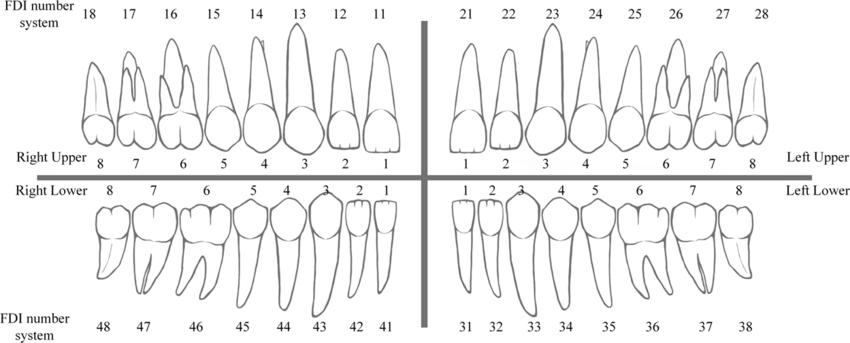
16
New cards
\
Labial Surface
Lingual Surface
Mesial Surface
Distal Surface
Incisal Surface
Labial Surface
Lingual Surface
Mesial Surface
Distal Surface
Incisal Surface
SURFACES OF TEETH
Anterior Teeth
Anterior Teeth
17
New cards
\
Buccal Surface
Lingual/Palatal Surface
Mesial Surface
Distal Surface
Occlusal Surface
Buccal Surface
Lingual/Palatal Surface
Mesial Surface
Distal Surface
Occlusal Surface
SURFACES OF TEETH
Posterior Teeth
Posterior Teeth
18
New cards
Labial Surface
In the incisors & canines, the surfaces towards the lips
19
New cards
Occlusal Surface
Broad chewing surface of the posterior.
20
New cards
Incisal Surface
Narrow cutting surface of the anterior teeth.
21
New cards
Proximal Surface
Surfaces of the teeth facing toward adjoining teeth in the same dental arch
22
New cards
Mesial
Towards the midline
23
New cards
Distal
Away from the midline
24
New cards
\
Mesiodistally
Faciolingually: Labiolingual(anterior); buccolingual (posterior)
Cervicoincisally (anterior)/ Cervico-occlusally (posterior)
Mesiodistally
Faciolingually: Labiolingual(anterior); buccolingual (posterior)
Cervicoincisally (anterior)/ Cervico-occlusally (posterior)
Divisions of Crown
25
New cards
\
MESIAL third
MIDDLE third
DISTAL third
MESIAL third
MIDDLE third
DISTAL third
Mesiodistally
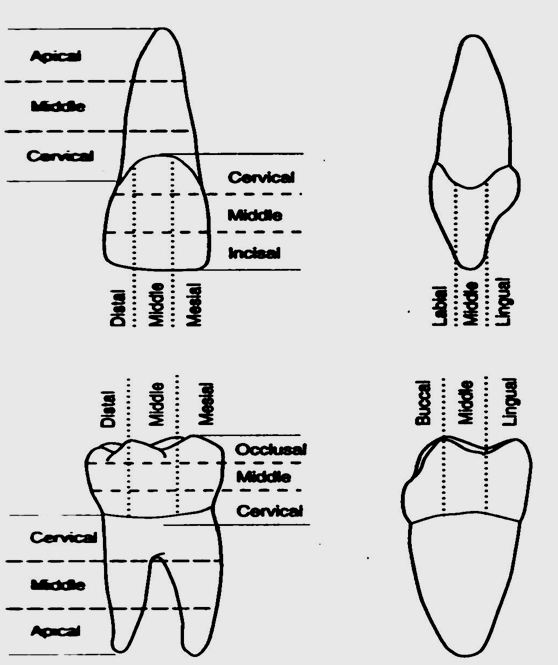
26
New cards
\
INCISAL (anterior) / OCCLUSAL (posterior) third
MIDDLE third
CERVICAL third
INCISAL (anterior) / OCCLUSAL (posterior) third
MIDDLE third
CERVICAL third
Cervico-occlusal/Cervicoincisally
27
New cards
\
LABIAL or BUCCAL third
MIDDLE third
LINGUAL third
LABIAL or BUCCAL third
MIDDLE third
LINGUAL third
Faciolingually
28
New cards
CERVICAL third
MIDDLE third
APICAL third
MIDDLE third
APICAL third
Divisions of the Root
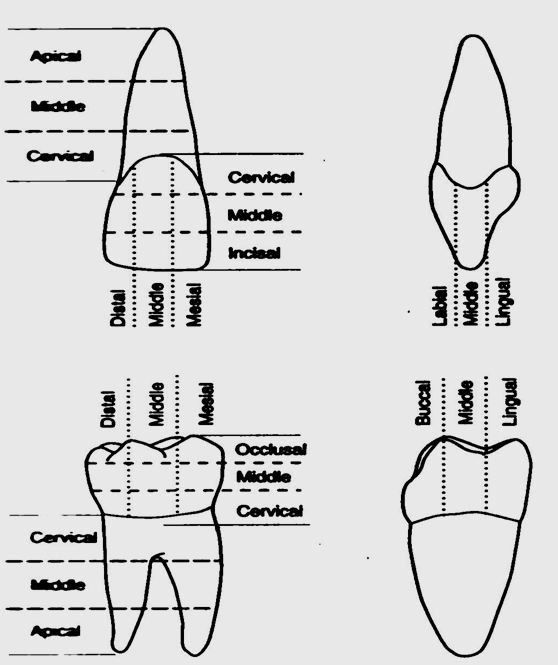
29
New cards
Line Angle
Formed by the junction of two surfaces
30
New cards
LABIOINCISAL
MESIOLINGUAL
MESIOLABIAL
LINGUOINCISAL
DISTOLINGUAL
DISTOLABIAL
MESIOLINGUAL
MESIOLABIAL
LINGUOINCISAL
DISTOLINGUAL
DISTOLABIAL
Anterior Line Angles
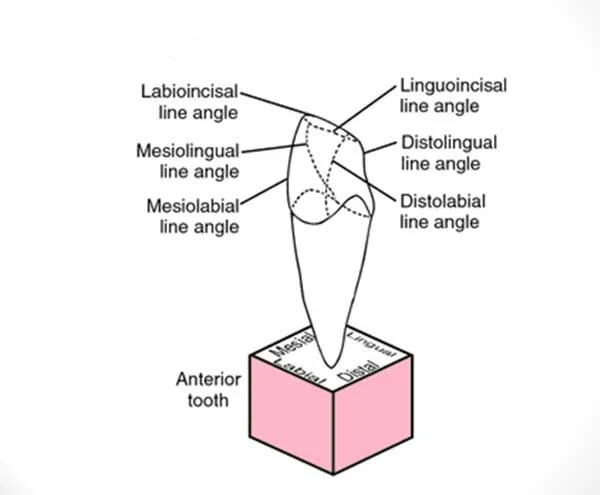
31
New cards
MESIO-OCCLUSAL
MESIOBUCCAL
BUCCO-OCCLUSAL
MESIOLINGUAL
LINGUO-OCCLUSAL
DISTOLINGUAL
DISTO-OCCLUSAL
DISTOBUCCAL
MESIOBUCCAL
BUCCO-OCCLUSAL
MESIOLINGUAL
LINGUO-OCCLUSAL
DISTOLINGUAL
DISTO-OCCLUSAL
DISTOBUCCAL
Posterior Line Angles
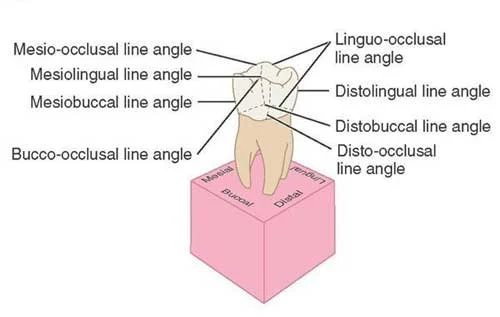
32
New cards
Point Angle
Formed by the junction of three surfaces
33
New cards
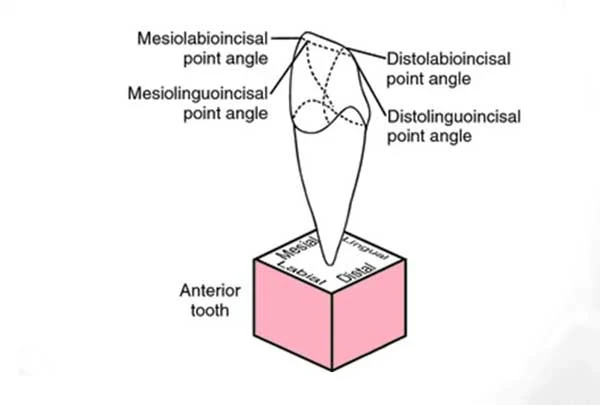
MESIOLABIOINCISAL
DISTOLABIOINCISAL
MESIOLINGUOINCISAL
DISTOLINUOINCISAL
DISTOLABIOINCISAL
MESIOLINGUOINCISAL
DISTOLINUOINCISAL
Anterior Point Angles
34
New cards

MESIOLINGUO-OCCLUSAL
MESIOBUCCO-OCCLUSAL
DISTOLINGUO-OCCLUSAL
DISTOBUCCO-OCCLUSAL
MESIOBUCCO-OCCLUSAL
DISTOLINGUO-OCCLUSAL
DISTOBUCCO-OCCLUSAL
Posterior Point Angles
35
New cards
Anatomic Landmarks on Tooth Surface
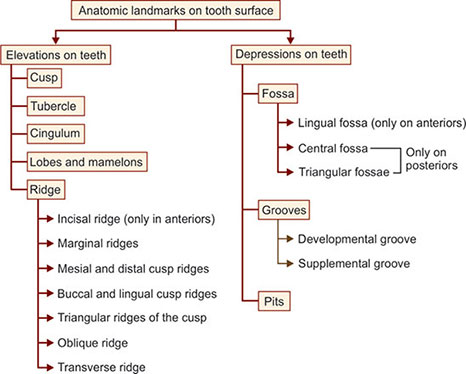
36
New cards
Functions of Teeth
Mastication
Esthetics
Speech
Protection of supporting tissues
Esthetics
Speech
Protection of supporting tissues
37
New cards
Height of contour (crest of curvature)
Is the greatest area of contour on the facial and lingual surfaces.
38
New cards
Convexity
Located at the cervical third of the crown on the facial surfaces of all teeth & the lingual surfaces of incisors and canines.
39
New cards
Middle third of the crown.
Where is the lingual surfaces of the posterior teeth usually have their height of contour?
40
New cards
Curvatures are too great
The tissues usually receive inadequate stimulation by the passage of the food.
41
New cards
Too little contour
May result in trauma to the attachment apparatus.
42
New cards
Contacts with the proximal surfaces of the adjacent teeth which prevents food impaction.
Adequate embrasure space gingivally for the gingival tissue, supporting bone, blood vessels and nerves that serve the supporting structures.
Adequate embrasure space gingivally for the gingival tissue, supporting bone, blood vessels and nerves that serve the supporting structures.
Proper proximal height of contour serves to provide:
43
New cards
Proximal contact areas
Areas on the surfaces of the teeth where the proximal surfaces touch one another.
44
New cards
Point Contact
It is seen in young persons with newly erupted teeth.
45
New cards
Contact area
It is formed due to wear of proximal surface against another during physiologic tooth movement.
46
New cards
Incisal third
Where is the proximal contact of maxillary and mandibular incisors located?
47
New cards
Incisal/occlusal thirds and middle thirds
Where is the contact area of the remaining teeth going posteriorly located?
48
New cards
Stabilize the dental arches by combined anchorage effect of all the teeth
Serves to keep food away from packing between the teeth
Protect interdental papillae.
Serves to keep food away from packing between the teeth
Protect interdental papillae.
Importance of proper contact relation:
49
New cards
Embrasures
open space; Spillways
V-shaped spaces that originate at the proximal contact areas between adjacent teeth
V-shaped spaces that originate at the proximal contact areas between adjacent teeth
50
New cards
FACIAL (buccal or labial)
LINGUAL
INCISAL or OCCLUSAL
GINGIVAL
LINGUAL
INCISAL or OCCLUSAL
GINGIVAL
Name for the location of Embrasures
51
New cards
Gingival embrasure
What does the interdental papilla fill?
52
New cards
Col
(Valley) central faciolingual concave area beneath the contact
Vulnerable to periodontal disease from incorrect contact and embrasure form because it is covered by nonkeratinized epithelium.
Vulnerable to periodontal disease from incorrect contact and embrasure form because it is covered by nonkeratinized epithelium.
53
New cards
FALSE. They are larger
TRUE OR FALSE. Are lingual embrasure smaller than facial embrasures?
54
New cards
Triangular
In faciolingual section, interdental papila between anterior teeth is shaped as
55
New cards
Mountain range
In faciolingual section, interdental papila between posterior teeth is shaped as
56
New cards
TRUE
TRUE OR FALSE. The lingual embrasure is usually larger than the facial to allow more food to be displaced lingually
57
New cards
FALSE. It should be the same
TRUE OR FALSE. The marginal ridges of the adjacent posterior teeth should be at the different height to have proper contact and embrasure forms
58
New cards
TRUE
TRUE OR FALSE. Correct anatomic form renders the teeth more self-cleansing.
59
New cards
Correct relationships of embrasures, marginal ridge contours, grooves of adjacent and opposing teeth provide escape of food from occlusal surfaces during mastication.
If embrasure size is decreased / absent, then additional forces are created in the teeth and supporting tissues during mastication.
If embrasure size is enlarged, food impaction occurs in interproximal space by opposing cusp, resulting in damage to supporting tissues.
If embrasure size is decreased / absent, then additional forces are created in the teeth and supporting tissues during mastication.
If embrasure size is enlarged, food impaction occurs in interproximal space by opposing cusp, resulting in damage to supporting tissues.
Significance of Embrasures